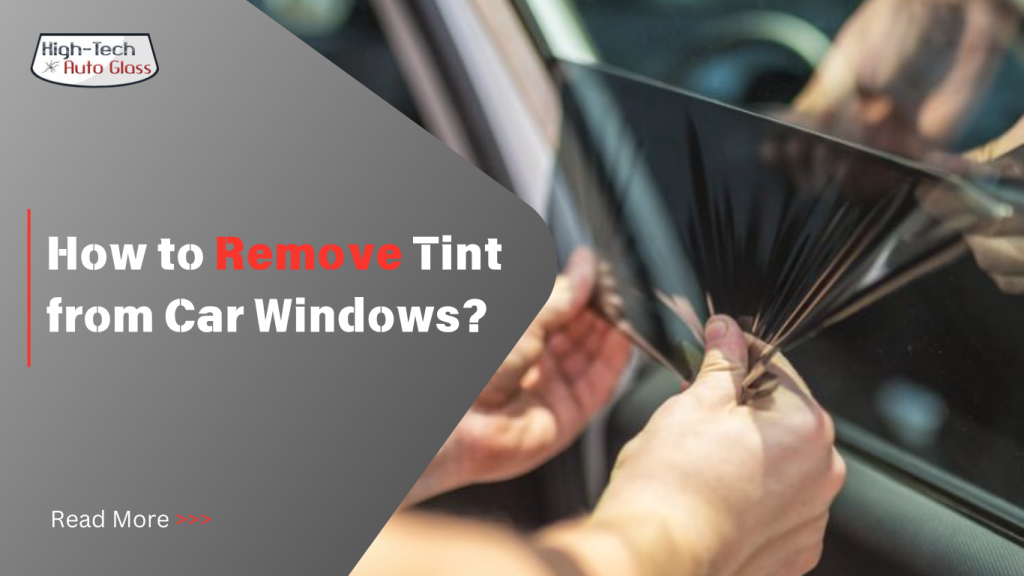How to Remove Tint from Car Windows

Removing window tint from your car can be necessary for various reasons, such as damage, discoloration, or to comply with legal regulations. Over time, tints may lose their appeal or functionality, prompting the need for removal. While the process may seem challenging, with the right guidance, it can be done efficiently and safely.
This guide focuses on providing clear and actionable steps for safely removing window tint, making the process straightforward and hassle-free.
Tools and Materials for Removing Tint from Window
Removing tint from the car window requires the right tools to ensure a smooth and damage-free process. Here’s a list of essential tools and a brief explanation of their roles:
- Heat Gun or Hair Dryer
- Razor Blades or Scrapers
- Adhesive Remover or Window Tint Removal Spray
- Soap, Water, or Ammonia
- Black Plastic Bags
Using improper tools or techniques during tint removal can lead to scratches on the glass. Learning how to prevent scratches on your car windows is critical to ensure the removal process doesn’t cause lasting damage.
Using tools like a heat gun or scraper, along with adhesive remover, softens and lifts the tint efficiently. Adding soap, water, or ammonia helps dissolve residue, while plastic bags trap heat to loosen adhesive further.
With these tools and materials, removing window tint becomes a manageable task, ensuring a clean and clear finish.
Window tinting provides advantages like reducing glare, blocking harmful UV rays, and improving the vehicle’s overall aesthetic. However, damaged or aging tints can reduce these advantages and might require removal. Understanding the benefits of tinting car windows helps evaluate whether re-tinting is the right option after removal.
How to Remove Tint from Car Windows (Step-by-Step Guide)
Best Way to Remove Window Tint
Removing window tint can be done effectively using a few proven methods. Below are the most common approaches:
Heating and Peeling
Use a heat gun or hair dryer to warm the tint, softening the adhesive underneath. Once heated, gently lift a corner of the tint using a razor blade or scraper and slowly peel it off. This method ensures minimal tearing and leaves less residue behind.
Steam Method
Apply steam using a handheld steamer to loosen the adhesive. The combination of heat and moisture helps the tint peel off in larger sections, making the process faster and easier.
Chemical Method
Spray the tint with ammonia or a window tint removal spray, then cover it with a black plastic bag to trap heat and allow the solution to soak for about 30 minutes. Afterward, peel off the tint and clean the glass to remove any adhesive residue.
After removing window tint, adhesive residues may stick to the glass surface, especially on the inside of the windshield. Proper techniques to clean the inside of your windshield are essential to ensure a streak-free, polished finish without damaging the glass.
How to Take Tint Off Windows Without Damaging Glass
Removing tint without damaging your car’s windows or defroster lines requires a careful approach. Follow these tips to ensure a smooth and safe process:
- Use Proper Tools: Opt for plastic scrapers or specialized tools instead of metal razor blades to minimize the risk of scratching the glass.
- Apply Heat Evenly: When using a heat gun or hair dryer, move it in consistent motions to avoid overheating one spot.
- Work Slowly: Peel the tint gradually to prevent tears and reduce strain on defroster lines.
- Clean Residue Gently: Use a microfiber cloth with a mild adhesive remover or soapy water to wipe away any leftover glue without causing scratches.
By following these methods, you can safely remove window tint while keeping your car’s windows in pristine condition.
Once the tint is removed, maintaining clear and spotless windows is essential. Persistent issues, such as water spots, can make windows look dull and reduce visibility. Knowing how to remove water spots from windows ensures your car’s glass stays clean and clear after tint removal.
Removing Window Film Adhesive Residue
How to Remove Window Film Adhesive Safely
After peeling off window tint, adhesive residue often remains on the glass. Here’s how to remove it safely:
- Use soapy water, ammonia, or a window tint removal spray to soften the glue.
- Spray the solution onto the residue and let it sit for a few minutes to break down the adhesive.
- Use a microfiber cloth or a soft sponge to scrub the residue. Avoid using abrasive materials to prevent scratches.
- Clean the glass with water and dry it with a lint-free cloth to ensure a clear finish.
How to Get Window Tint Glue Off Quickly
If you’re short on time, try these tips for faster adhesive removal:
- Apply vinegar, rubbing alcohol, or Goo Gone to the glue. These items effectively dissolve adhesive and are easily accessible.
- Use a hair dryer or heat gun to warm the adhesive, making it easier to wipe away.
- For stubborn residue, combine heat and a cleaning solution for faster results.
By using these techniques, you can efficiently remove adhesive residue without damaging your car windows, leaving them clean and ready for retinting or regular use.
Common Challenges and Solutions
Is Removing Tint from Car Windows Hard?
Removing window tint from car windows can be challenging, but with the right tools and techniques, it is manageable. Common difficulties include:
- Stubborn Adhesive Residue: Some adhesives are resistant and require multiple applications of cleaning solutions or specialized adhesive removers.
- Fragile Defroster Lines: Rear windows with defroster lines are particularly tricky as improper techniques can damage these delicate components. Careful handling is essential to avoid costly repairs.
- Multiple Tint Layers: Older tints may have multiple layers, making the removal process more time-consuming.
While DIY methods can work, professional services are often recommended for complex cases to avoid potential damage to the windows or defroster lines.
What Not to Use on Tinted Windows
To prevent damage, avoid using these items when cleaning or removing tint:
- Abrasive Materials: Steel wool, scouring pads, or rough sponges can scratch the glass or harm defroster lines.
- Harsh Chemicals: Products containing ammonia, bleach, or strong acids can discolor or weaken the tint film.
- Razor Blades on Defrosters: Metal tools can easily damage defroster lines and should not be used on rear windows.
- Non-Specialized Cleaners: Stick to products designed specifically for automotive tint or glass to prevent peeling or fading over time.
How to Remove Tint from Rear Window Without Damaging Defroster Lines
Rear window tint removal requires extra care due to the presence of defroster lines. Here’s how to do it safely:
Heat the Tint
Use a heat gun or hair dryer to evenly warm the tint. The heat softens the adhesive, making it easier to peel off without pulling on the defroster lines.
Peel Carefully
Start at a corner and gently lift the tint using a plastic scraper or your fingers. Avoid scraping directly over the defroster lines.
Soften Adhesive
Apply a mild ammonia solution or window tint removal spray to further loosen the adhesive as you peel. Let it soak for a few minutes if necessary.
Clean Residue Gently
Use a microfiber cloth with a mild adhesive remover or soapy water to wipe away any remaining glue. Avoid harsh scrubbing to protect the defroster.
By following these steps and using the right tools, you can remove rear window tint safely while preserving the functionality of the defroster lines.
Car tints often provide UV protection, but with the tint removed, the ability of car windows to block UV rays depends on the type of glass used. If UV protection is a priority, it’s worth understanding how much your vehicle’s glass can block harmful rays naturally.
DIY vs Professional Window Tint Removal
Aspect | DIY Approach | Professional Approach |
Cost | Low cost with basic tools. | Higher cost for expertise and tools. |
Time Commitment | Time-intensive for stubborn or multiple windows. | Faster due to professional efficiency. |
Tools and Materials | Basic tools like heat gun, scrapers, and cleaning solutions. | Specialized tools for precise and efficient removal. |
Skill Level | Requires patience and precision, especially for rear windows. | Skilled professionals handle complex cases seamlessly. |
Risk of Damage | Higher risk of scratches or defroster damage due to inexperience. | Minimal risk with professional tools and techniques. |
Best for | Budget-conscious individuals with simple, single-layer tints. | Complex, high-end, or multi-layer tints, and delicate defroster lines. |
Expertise | No formal expertise but requires a learning curve. | Extensive experience ensures flawless results. |
Convenience | Requires effort and preparation. | Hassle-free and time-saving. |
When to Choose | For cost-saving and simple cases. | For delicate windows, high-end tints, or multiple windows. |
Outcome | Results depend on skill; risk of uneven removal or residue. | Clean, consistent, and professional finish. |
Conclusion
Removing window tint can be challenging and time-intensive, particularly for older or complex tints. DIY methods may suffice for simple cases, but professional expertise guarantees a flawless and safe outcome.
High-Tech Autoglass provides expert tint removal and windshield replacement services in Phoenix and surrounding areas. Using advanced tools and skilled technicians, we ensure precision and protection for your vehicle. Choose High-Tech Autoglass for dependable service that keeps your car looking and performing its best.
Frequently Asked Questions
How Do You Remove Auto Window Tint?
Removing auto window tint involves softening the adhesive with heat, steam, or a chemical solution. Once the adhesive loosens, peel the tint carefully from the edges and clean the glass to remove residue. For the best results, use tools like a heat gun or adhesive remover.
How to Take Tint Off Without Leaving Residue?
To avoid residue, warm the tint with a heat gun or steam before peeling. Use an adhesive remover or soapy water to clean any leftover glue. Patience is key to ensuring the glass stays spotless.
Does Spray-On Tint Work for Car Windows?
Spray-on tint can provide temporary shading, but it’s not as durable or effective as traditional film. It may also be harder to remove and can leave streaks if not applied properly.
How to Remove Sticker Off Tint Without Damage?
Gently heat the sticker with a hair dryer to loosen the adhesive. Peel it off slowly and clean the area with soapy water or rubbing alcohol to avoid damaging the tint film.
How to Cure Tinted Windows Faster After Retinting?
Park your car in direct sunlight or a warm, dry area to speed up curing. Avoid rolling down the windows for at least a few days to allow the adhesive to set properly.
Can I Retint Windows Immediately After Removing Old Tint?
Yes, but ensure the glass is thoroughly cleaned and free of adhesive residue. A clean surface ensures the new tint adheres properly and lasts longer.
Will Removing Tint Affect My Defroster Lines?
Improper removal can damage defroster lines. Use steam or chemical solutions to loosen the adhesive and peel carefully to preserve the functionality of the defroster.
What Is the Best Way to Clean Tinted Windows After Removal?
Use a mild glass cleaner that is ammonia-free and a microfiber cloth to avoid streaks. Avoid harsh chemicals that could damage the glass or leave residue.
